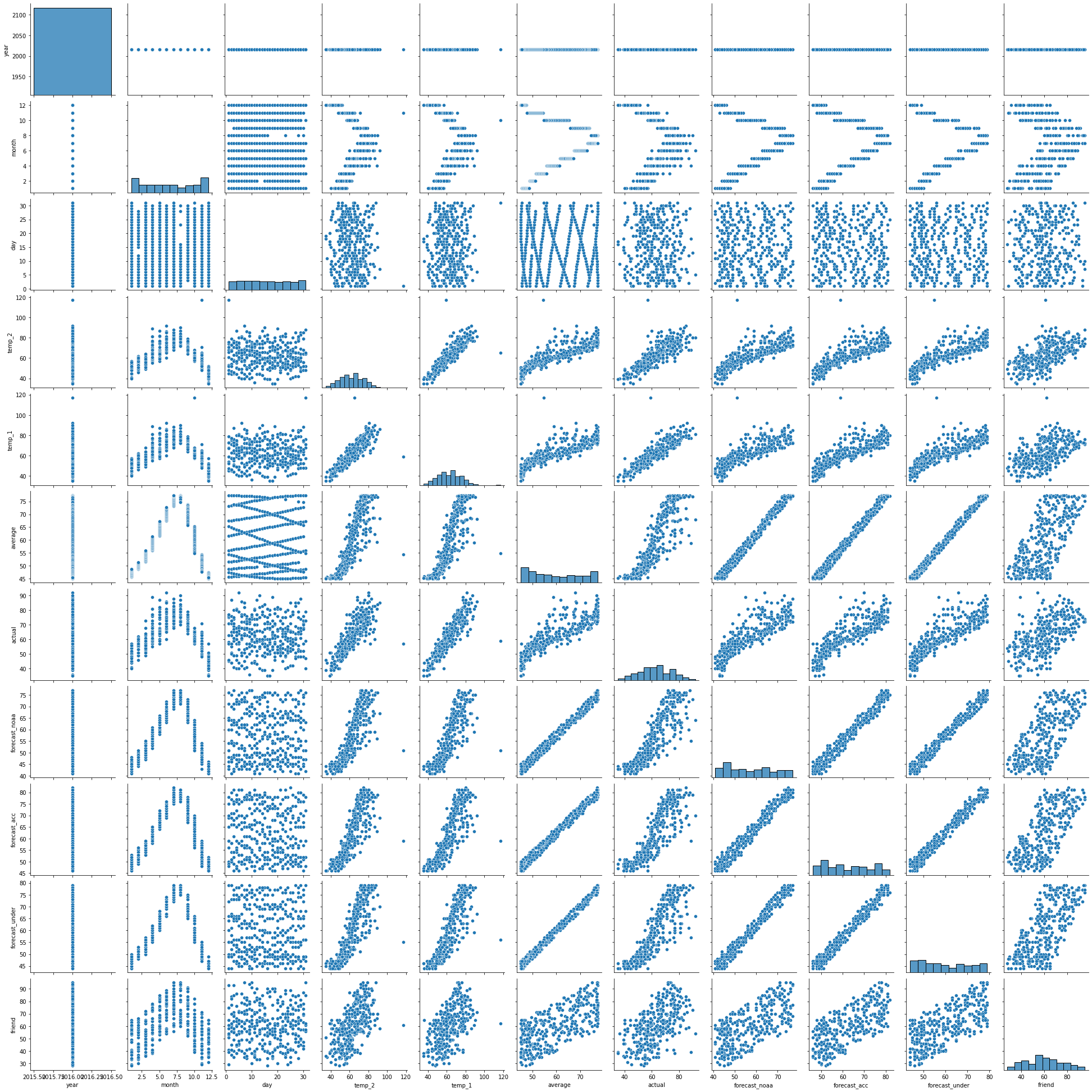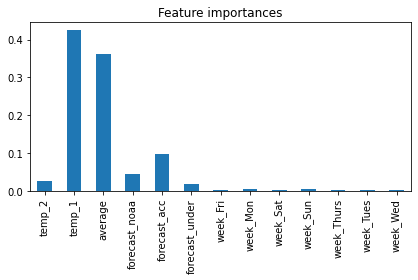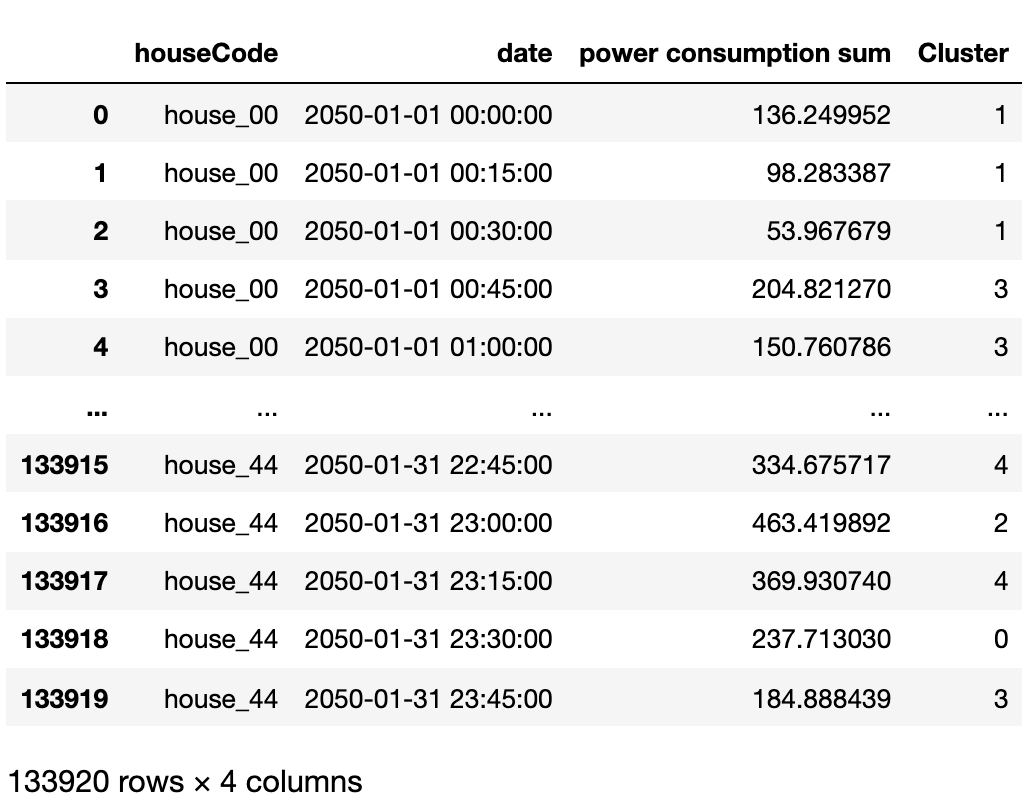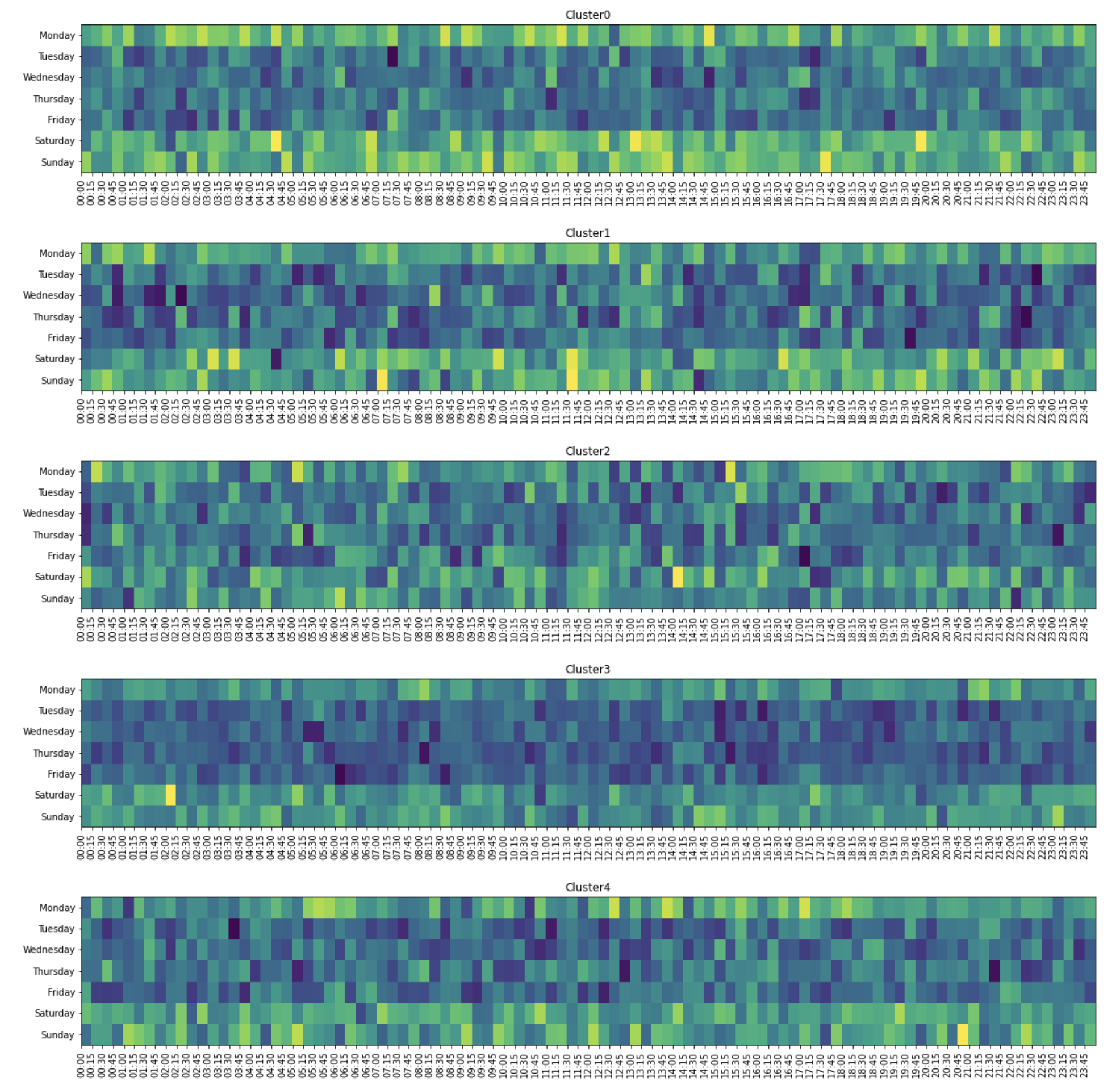ADP 20회 실기 문제#
풀이가 궁금하시다면 단톡방에서 문의주세요!!! 올 때 광고클릭
Attention
캐글에 업로드된 다른 분들 코드 보러가기
문제오류, 코드오류 댓글로 피드백주세요
Attention
1번
날씨 온도 예측, 종속변수 :actual(최고온도)
데이터 출처 : https://towardsdatascience.com/random-forest-in-python-24d0893d51c0
데이터 경로 : /kaggle/input/adp-kr-p2/problem1.csv
temp_1 : 전날 최고온도
temp_2 : 전전날 최고온도
friend : 친구의 예측온도
1-1번
데이터 확인 및 전처리
데이터 EDA 수행
결측치를 확인하고 처리 방안에 대해 논의하라
데이터 분할 방법 설명
최종 데이터셋이 적절함을 주장하라
Show code cell content
import pandas as pd
import seaborn as sns
df =pd.read_csv('https://raw.githubusercontent.com/Datamanim/datarepo/main/adp/20/problem1.csv')
print(df.head()) # 상위 5개
print(df.shape) # 데이터 형태
display(sns.pairplot(df)) # 변수별 상관계쑤
print(df.info()) # 각 컬럼 데이터 타입
print(df.describe()) # 기초 통계량
print(df.isnull().sum()) #결측치 확인
df['date'] =df['year'].astype('str')+'-'+df['month'].astype('str')+'-'+df['day'].astype('str')
df['date'] = pd.to_datetime(df['date'])
v = pd.DataFrame(pd.date_range(start=df['date'].dt.strftime('%Y-%m-%d').min(), end=df['date'].dt.strftime('%Y-%m-%d').max()))[0].dt.strftime('%Y-%m-%d').values
a=set(v) - set(df['date'].dt.strftime('%Y-%m-%d'))
print(a)
len(a)
display(df.corr())
# 데이터 분할
dfd = pd.get_dummies(df)
df_drop = dfd.drop(columns=['year','month','day','friend','date'])
X = df_drop.drop(columns=['actual'])
y = df_drop['actual']
from sklearn.model_selection import train_test_split
X_train,X_test , y_train,y_test = train_test_split(X,y,random_state=2,test_size=0.2)
plt.show()
print('''
Answer
데이터 상에서 수치 결측치는 존재하지 않는다. 시계열 데이터 관점으로 봤을때, 18일치의 일자 데이터가 결측치로 존재한다.
문제 해결시 시계열 방식으로 접근 하지 않을 것이기에 누락된 일자에 대해서 따로 결측치 처리를 해주지 않을 것이다.
시계열 관점으로 해석을 할 경우 누락된 데이터는 평균 보간을 실시 하여 처리할 수 있다.
데이터 시각화 결과 상관관계를 보이는 컬럼들이 확인되며 주기적 경향을 보이는 데이터들이 확인된다.
year, month, day, week, 값은 불필요 컬럼으로 제외한다. week의 경우 원핫인코딩을 진행해서 추가한다.
train셋과 test셋은 8:2비율로 나눠서 모델링을 진행한다.
friend 컬럼의 경우 상관관계를 확인했을때 상대적으로 낮은 값을 가지기에 제외하고 학습을 진행한다.
''')
year month day week temp_2 temp_1 average actual forecast_noaa \
0 2016 1 1 Fri 45 45 45.6 45 43
1 2016 1 2 Sat 44 45 45.7 44 41
2 2016 1 3 Sun 45 44 45.8 41 43
3 2016 1 4 Mon 44 41 45.9 40 44
4 2016 1 5 Tues 41 40 46.0 44 46
forecast_acc forecast_under friend
0 50 44 29
1 50 44 61
2 46 47 56
3 48 46 53
4 46 46 41
(348, 12)
<seaborn.axisgrid.PairGrid at 0x7ff6fd534e20>
<class 'pandas.core.frame.DataFrame'>
RangeIndex: 348 entries, 0 to 347
Data columns (total 12 columns):
# Column Non-Null Count Dtype
--- ------ -------------- -----
0 year 348 non-null int64
1 month 348 non-null int64
2 day 348 non-null int64
3 week 348 non-null object
4 temp_2 348 non-null int64
5 temp_1 348 non-null int64
6 average 348 non-null float64
7 actual 348 non-null int64
8 forecast_noaa 348 non-null int64
9 forecast_acc 348 non-null int64
10 forecast_under 348 non-null int64
11 friend 348 non-null int64
dtypes: float64(1), int64(10), object(1)
memory usage: 32.8+ KB
None
year month day temp_2 temp_1 average \
count 348.0 348.000000 348.000000 348.000000 348.000000 348.000000
mean 2016.0 6.477011 15.514368 62.652299 62.701149 59.760632
std 0.0 3.498380 8.772982 12.165398 12.120542 10.527306
min 2016.0 1.000000 1.000000 35.000000 35.000000 45.100000
25% 2016.0 3.000000 8.000000 54.000000 54.000000 49.975000
50% 2016.0 6.000000 15.000000 62.500000 62.500000 58.200000
75% 2016.0 10.000000 23.000000 71.000000 71.000000 69.025000
max 2016.0 12.000000 31.000000 117.000000 117.000000 77.400000
actual forecast_noaa forecast_acc forecast_under friend
count 348.000000 348.000000 348.000000 348.000000 348.000000
mean 62.543103 57.238506 62.373563 59.772989 60.034483
std 11.794146 10.605746 10.549381 10.705256 15.626179
min 35.000000 41.000000 46.000000 44.000000 28.000000
25% 54.000000 48.000000 53.000000 50.000000 47.750000
50% 62.500000 56.000000 61.000000 58.000000 60.000000
75% 71.000000 66.000000 72.000000 69.000000 71.000000
max 92.000000 77.000000 82.000000 79.000000 95.000000
year 0
month 0
day 0
week 0
temp_2 0
temp_1 0
average 0
actual 0
forecast_noaa 0
forecast_acc 0
forecast_under 0
friend 0
dtype: int64
{'2016-02-14', '2016-08-31', '2016-08-20', '2016-08-27', '2016-08-18', '2016-10-30', '2016-08-25', '2016-08-22', '2016-09-01', '2016-08-24', '2016-02-29', '2016-09-02', '2016-08-21', '2016-08-26', '2016-08-19', '2016-08-29', '2016-02-13', '2016-08-17'}
| year | month | day | temp_2 | temp_1 | average | actual | forecast_noaa | forecast_acc | forecast_under | friend | |
|---|---|---|---|---|---|---|---|---|---|---|---|
| year | NaN | NaN | NaN | NaN | NaN | NaN | NaN | NaN | NaN | NaN | NaN |
| month | NaN | 1.000000 | -0.000412 | 0.047651 | 0.032664 | 0.120806 | 0.004529 | 0.131141 | 0.127436 | 0.119786 | 0.048145 |
| day | NaN | -0.000412 | 1.000000 | -0.046194 | -0.000691 | -0.021136 | -0.021675 | -0.021393 | -0.030605 | -0.013727 | 0.024592 |
| temp_2 | NaN | 0.047651 | -0.046194 | 1.000000 | 0.857800 | 0.821560 | 0.805835 | 0.813134 | 0.817374 | 0.819576 | 0.583758 |
| temp_1 | NaN | 0.032664 | -0.000691 | 0.857800 | 1.000000 | 0.819328 | 0.877880 | 0.810672 | 0.815162 | 0.815943 | 0.541282 |
| average | NaN | 0.120806 | -0.021136 | 0.821560 | 0.819328 | 1.000000 | 0.848365 | 0.990340 | 0.990705 | 0.994373 | 0.689278 |
| actual | NaN | 0.004529 | -0.021675 | 0.805835 | 0.877880 | 0.848365 | 1.000000 | 0.838639 | 0.842135 | 0.838946 | 0.569145 |
| forecast_noaa | NaN | 0.131141 | -0.021393 | 0.813134 | 0.810672 | 0.990340 | 0.838639 | 1.000000 | 0.979863 | 0.985670 | 0.669221 |
| forecast_acc | NaN | 0.127436 | -0.030605 | 0.817374 | 0.815162 | 0.990705 | 0.842135 | 0.979863 | 1.000000 | 0.983910 | 0.696054 |
| forecast_under | NaN | 0.119786 | -0.013727 | 0.819576 | 0.815943 | 0.994373 | 0.838946 | 0.985670 | 0.983910 | 1.000000 | 0.691177 |
| friend | NaN | 0.048145 | 0.024592 | 0.583758 | 0.541282 | 0.689278 | 0.569145 | 0.669221 | 0.696054 | 0.691177 | 1.000000 |

Answer
데이터 상에서 수치 결측치는 존재하지 않는다. 시계열 데이터 관점으로 봤을때, 18일치의 일자 데이터가 결측치로 존재한다.
문제 해결시 시계열 방식으로 접근 하지 않을 것이기에 누락된 일자에 대해서 따로 결측치 처리를 해주지 않을 것이다.
시계열 관점으로 해석을 할 경우 누락된 데이터는 평균 보간을 실시 하여 처리할 수 있다.
데이터 시각화 결과 상관관계를 보이는 컬럼들이 확인되며 주기적 경향을 보이는 데이터들이 확인된다.
year, month, day, week, 값은 불필요 컬럼으로 제외한다. week의 경우 원핫인코딩을 진행해서 추가한다.
train셋과 test셋은 8:2비율로 나눠서 모델링을 진행한다.
friend 컬럼의 경우 상관관계를 확인했을때 상대적으로 낮은 값을 가지기에 제외하고 학습을 진행한다.
1-2번
Random Forest 모델 적합 및 검증
Random Forest 학습 및 예측 결과 해석
예측 결과 검정 해석, 중요변수 도출
변수 중요성 분석 및 그래프 출력
Show code cell content
from sklearn.ensemble import RandomForestRegressor
from sklearn.metrics import r2_score
import time
import matplotlib.pyplot as plt
result = []
rf = RandomForestRegressor(random_state=22)
start = time.time()
rf.fit(X_train,y_train)
end = time.time()
pred = rf.predict(X_test)
print('RandomForest r2_score : ',r2_score(y_test,pred))
print('learning time ',end-start)
importances = rf.feature_importances_
forest_importances = pd.Series(importances, index=X_train.columns)
fig, ax = plt.subplots()
forest_importances.plot.bar( ax=ax)
ax.set_title("Feature importances")
fig.tight_layout()
print('temp_1 ,average , forecast_acc 순으로 변수 중요도를 확인 할 수 있다')
result.append([end-start,r2_score(y_test,pred)])
RandomForest r2_score : 0.8399186619591019
learning time 0.1347370147705078
temp_1 ,average , forecast_acc 순으로 변수 중요도를 확인 할 수 있다

1-3번
SVM(Support Vector Machine) 모델 적합 및 검증
svm 학습 및 예측 결과 해석
예측 결과 검정 해석, 중요변수 도출
변수 중요성 분석 및 그래프 출력
Show code cell source
from sklearn.svm import SVR
from sklearn.metrics import r2_score
import time
svm = SVR()
start = time.time()
svm.fit(X_train,y_train)
end = time.time()
pred = svm.predict(X_test)
print('svm r2_score : ',r2_score(y_test,pred))
print('learning time ',end-start)
print('svm은 변수 중요도를 따로 추출 할 수 없다. r2_score의 경우 RandomForest에 비해 낮다')
result.append([end-start,r2_score(y_test,pred)])
svm r2_score : 0.8138036782618503
learning time 0.008105278015136719
svm은 변수 중요도를 따로 추출 할 수 없다. r2_score의 경우 RandomForest에 비해 낮다
1-4번
모델 비교 및 향후 개선 방향 도출
Random Forest, SVM 모델의 결과 비교 후 최종 모델 선택
두 모델의 장단점 분석, 추후 운영 관점에서 어떤 모델을 선택할 것인가?
모델링 관련 추후 개선 방향 제시
Show code cell source
result_df = pd.DataFrame(result,columns = ['learning time','r2_score'])
result_df.index = ['RandomForest','Svm']
display(result_df)
print('''
파라미터 튜닝을 제외한 기본모델의 경우 모델학습시간은 랜덤포레스트가 svm에 비해 더 오래 걸린다.
test셋에 대한 모델 r2score는 랜덤포레스트가 더 높다.
모델 학습시간을 중점둔다면 svm이 더 유리하다. 하지만 랜덤포레스트의 경우 변수중요도를 확인 할 수 있고, 정확도가 더 높기 때문에
최종적으로는 랜덤포레스트를 선택한다.
''')
| learning time | r2_score | |
|---|---|---|
| RandomForest | 0.134737 | 0.839919 |
| Svm | 0.008105 | 0.813804 |
파라미터 튜닝을 제외한 기본모델의 경우 모델학습시간은 랜덤포레스트가 svm에 비해 더 오래 걸린다.
test셋에 대한 모델 r2score는 랜덤포레스트가 더 높다.
모델 학습시간을 중점둔다면 svm이 더 유리하다. 하지만 랜덤포레스트의 경우 변수중요도를 확인 할 수 있고, 정확도가 더 높기 때문에
최종적으로는 랜덤포레스트를 선택한다.
Attention
2번
5분간격의 가구별 전력 사용량의 데이터
데이터 출처 : 자체생성
데이터 경로 : https://raw.githubusercontent.com/Datamanim/datarepo/main/adp/p2/problem2.csv
import matplotlib.pyplot as plt
ttt= pd.read_csv('https://raw.githubusercontent.com/Datamanim/datarepo/main/adp/20/problem2.csv')
2-1번
데이터 전처리
각 가구의 15분간격의 전력량의 합을 구하고 해당데이터를 바탕으로 총 5개의 군집으로 군집화를 진행한 후 아래의 그림과 같은 형태로 출력하라.
군집화를 위한 데이터 구성의 이유를 설명하라
(군집 방식에 따라 Cluster컬럼의 값은 달라질수 있음)

Show code cell content
tt = ttt.sort_values(['houseCode','date']).reset_index(drop=True)
tt['date'] = pd.to_datetime(tt['date'])
tg = tt.groupby(['houseCode']).resample('15min', on='date')['power consumption'].sum().reset_index()
tg = tg.rename(columns= {'power consumption':'power consumption sum'})
tgg = tg.copy()
tgg['c'] =tgg['houseCode'].str[-2:].astype('int')
tgg['d'] =tgg['date'].dt.hour
tgg['e'] =tgg['date'].dt.day
from sklearn.cluster import KMeans
# k-means clustering 실행
kmeans = KMeans(n_clusters=5)
kmeans.fit(tgg.iloc[:,2:].values)
tg['Cluster'] =kmeans.labels_
tg
| houseCode | date | power consumption sum | Cluster | |
|---|---|---|---|---|
| 0 | house_00 | 2050-01-01 00:00:00 | 136.249952 | 4 |
| 1 | house_00 | 2050-01-01 00:15:00 | 98.283387 | 4 |
| 2 | house_00 | 2050-01-01 00:30:00 | 53.967679 | 4 |
| 3 | house_00 | 2050-01-01 00:45:00 | 204.821270 | 1 |
| 4 | house_00 | 2050-01-01 01:00:00 | 150.760786 | 1 |
| ... | ... | ... | ... | ... |
| 133915 | house_44 | 2050-01-31 22:45:00 | 334.675717 | 0 |
| 133916 | house_44 | 2050-01-31 23:00:00 | 463.419892 | 3 |
| 133917 | house_44 | 2050-01-31 23:15:00 | 369.930740 | 0 |
| 133918 | house_44 | 2050-01-31 23:30:00 | 237.713030 | 2 |
| 133919 | house_44 | 2050-01-31 23:45:00 | 184.888439 | 1 |
133920 rows × 4 columns
2-2번
히트맵 시각화
2-1의 데이터를 바탕으로 각 군집의 요일, 15분간격별 전력사용량의 합을 구한 후 아래와 같이 시각화 하여라
(수치는 동일하지 않을 수 있음 2-1의 데이터가 정확하게 아래와 같은 이미지로 변환 됐는지 주로 확인)

Show code cell content
import seaborn as sns
import matplotlib.pyplot as plt
import numpy as np
tg['day'] = tg.date.dt.day_name()
tg['min'] = tg.date.dt.strftime('%H:%M')
pv = tg.groupby(['Cluster','day','min'],as_index=False).sum()
for v in range(5):
plt.figure(figsize=(20,3))
target = pv.loc[pv.Cluster==v]
pvt = target.pivot(index='day',columns='min',values='power consumption sum').reindex(['Sunday','Saturday','Friday','Thursday','Wednesday','Tuesday','Monday'])
plt.pcolor(pvt)
plt.title('Cluster'+str(v))
plt.xticks(range(len(pvt.columns)),pvt.columns,rotation=90)
plt.yticks(np.arange(len(pvt.index))+0.5,pvt.index)





Attention
3번
태양광 데이터
데이터 출처 : https://www.kaggle.com/cheedcheed/california-renewable-production-20102018
데이터 경로 : https://raw.githubusercontent.com/Datamanim/datarepo/main/adp/p2/problem3.csv
예측 변수 :SOLAR PV
import pandas as pd
df= pd.read_csv('https://raw.githubusercontent.com/Datamanim/datarepo/main/adp/20/problem3.csv')
df.head()
| TIMESTAMP | BIOGAS | BIOMASS | GEOTHERMAL | Hour | SMALL HYDRO | SOLAR | SOLAR PV | SOLAR THERMAL | WIND TOTAL | |
|---|---|---|---|---|---|---|---|---|---|---|
| 0 | 2012-11-26 00:00:00 | 208.0 | 354.0 | 926.0 | 1.0 | 208.0 | NaN | 0.0 | 0.0 | 57.0 |
| 1 | 2012-11-26 01:00:00 | 207.0 | 354.0 | 927.0 | 2.0 | 207.0 | NaN | 0.0 | 0.0 | 76.0 |
| 2 | 2012-11-26 02:00:00 | 208.0 | 353.0 | 927.0 | 3.0 | 208.0 | NaN | 0.0 | 0.0 | 100.0 |
| 3 | 2012-11-26 03:00:00 | 208.0 | 350.0 | 927.0 | 4.0 | 209.0 | NaN | 0.0 | 0.0 | 111.0 |
| 4 | 2012-11-26 04:00:00 | 209.0 | 352.0 | 927.0 | 5.0 | 209.0 | NaN | 0.0 | 0.0 | 131.0 |
3-1번
데이터셋 분할 및 결과 검증
데이터셋 7:3 분할
데이터 전처리 및 예측 모델 생성
모델 성능 검증 : RMSE, R제곱, 정확도(아래 방식으로 연산)로 구하여라
정확도의 경우 실제값>예측값인 경우 (1-예측값/실제값), 실제값<예측값인 경우 (1- 실제값/예측값)으로 하고 이것들을 평균낸 후 1에서 뺀값으로 한다.
분수식의 분모가 0인 경우의 정확도는 0.5로 취급한다.최종 결과 제출 : 소수점 3째자리 반올림
Show code cell content
from sklearn.model_selection import train_test_split
from sklearn.metrics import r2_score,accuracy_score, mean_squared_error
from sklearn.ensemble import RandomForestRegressor
df = df.drop(columns =['SOLAR'])
def suntimeChecker(x):
if pd.to_datetime(x).hour in list(range(6,18)):
return 1
else:
return 0
df['TIMESTAMP'] = pd.to_datetime(df['TIMESTAMP'])
df['suntime'] = df['TIMESTAMP'].apply(suntimeChecker)
X = df.drop(columns=['TIMESTAMP','Hour','SOLAR PV'])
y= df['SOLAR PV']
X_train,X_test ,y_train,y_test = train_test_split(X,y,random_state =2 , test_size =0.3)
rf =RandomForestRegressor()
rf.fit(X_train,y_train)
pred = rf.predict(X_test)
def getEachAccuracy(y_true,y_pred):
if y_true ==0:
return 0.5
if y_pred ==0:
return 0.5
if y_true > y_pred:
return 1-(y_pred/y_true)
else:
return 1-(y_true/y_pred)
acc = []
for i,v in enumerate(y_test):
acc.append(getEachAccuracy(v,pred[i]))
# 데이터 전처리의 경우 날짜 컬럼을 제외하고, nan값만 있는 컬럼을 제외했다.
# 해가 존재하는시각을 (06~17시)로 설정해서 파생변수를 만들어줬다
# 정확도의 경우 아래와 같다
print('RMSE',round(mean_squared_error(y_test, pred)**0.5,3))
print('r2',round(r2_score(y_test, pred),3))
print('acc',1- round(sum(acc)/len(acc),3))
RMSE 702.12
r2 0.914
acc 0.623

